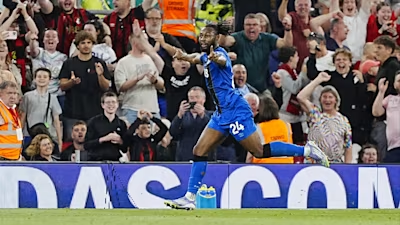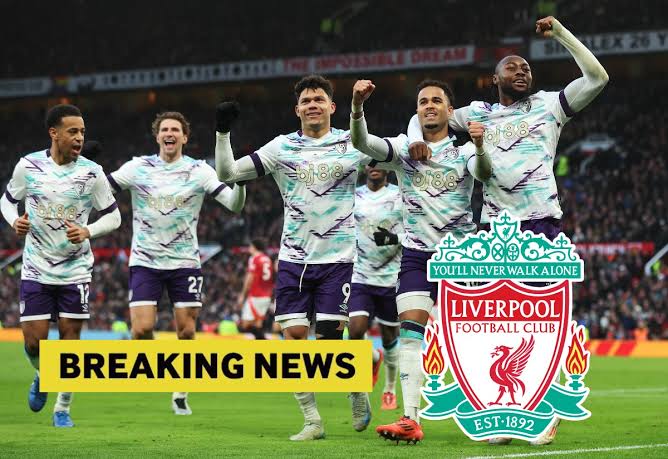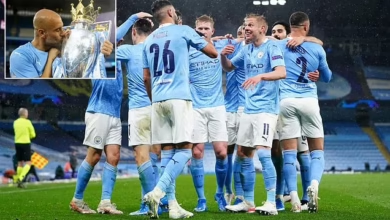Man arrested over alleged Semenyo racist abuse banned from all football stadiums

The beautiful game of football has long been marred by incidents of racism, and the opening weekend of the 2024-25 Premier League season provided yet another stark reminder of this persistent problem. When AFC Bournemouth’s Antoine Semenyo stepped onto the hallowed turf of Anfield to face Liverpool on Friday, August 15, 2025, he could hardly have anticipated that the match would be remembered not just for its thrilling comeback attempt, but for an incident of racial abuse that would once again thrust the issue of discrimination in football into the spotlight.
The swift response from both law enforcement and football authorities in the aftermath of this incident represents a significant moment in the ongoing fight against racism in sport. The arrest of a 47-year-old Liverpool man and his subsequent ban from all football stadiums across the United Kingdom sends a clear message that such behavior will not be tolerated at any level of the game.
Liverpool’s iconic Anfield stadium, home to the Reds since 1892, has witnessed countless memorable moments throughout its storied history. However, the events that unfolded during the 29th minute of Liverpool’s Premier League opener against Bournemouth will be remembered for all the wrong reasons. As Antoine Semenyo, the 25-year-old Ghanaian international forward, went about his business on the pitch, he was subjected to racial abuse from a spectator in the stands.
The incident was significant enough to prompt match referee Anthony Taylor to halt play entirely—a decision that speaks volumes about the severity of what had occurred. In modern football, stopping a match for any reason is not taken lightly, particularly during a Premier League fixture that attracts global attention and significant commercial interests. The fact that Taylor felt compelled to interrupt the flow of the game demonstrates both the audible nature of the abuse and the referee’s commitment to protecting players from discrimination.
The immediate response was swift and decisive. Stadium security personnel, working in conjunction with stewards and police officers present at the venue, quickly identified and ejected the offending fan from Anfield. This rapid intervention not only removed the source of the abuse but also sent a clear message to the 54,000 other spectators in attendance that such behavior would result in immediate consequences.
The football match itself provided a dramatic backdrop to these troubling events. Liverpool, playing their first Premier League game of the new season under manager Jürgen Klopp, had started strongly and built a commanding two-goal lead. For Bournemouth, managed by Andoni Iraola, this represented a challenging start to their campaign against one of England’s most formidable teams at one of the most intimidating venues in world football.
However, the Cherries demonstrated remarkable resilience and character, particularly in the second half. Antoine Semenyo, the very player who had been subjected to racist abuse earlier in the match, became the catalyst for Bournemouth’s remarkable comeback attempt. The 25-year-old forward found the net twice in the second half, helping to level the score and demonstrating the kind of mental fortitude that speaks to both his individual character and the collective spirit of his team.
Despite Semenyo’s heroics and Bournemouth’s spirited fightback, Liverpool ultimately prevailed with a 4-2 victory. However, the match will be remembered as much for the racist incident and the response it generated as for the football played on the pitch.
Antoine Semenyo’s journey to Premier League prominence is a testament to perseverance and talent. Born in England to Ghanaian parents, the forward has represented Ghana at international level, earning his first cap in 2023. His path to the top flight of English football has been far from straightforward, having developed through the youth systems and lower leagues before establishing himself as a key player for Bournemouth.
Standing at an imposing 6’1″, Semenyo combines physical presence with technical ability and pace, making him a constant threat to opposing defenses. His versatility allows him to operate across the front line, whether as a central striker or out wide, providing tactical flexibility for his managers. The fact that he was able to respond to racial abuse by delivering a performance of such quality speaks volumes about his mental strength and professional attitude.
His international career with Ghana has seen him represent his heritage on the biggest stage, including appearances in major tournaments. This dual identity—being both English-born and proudly Ghanaian—makes him a symbol of modern football’s multicultural nature and highlights the absurdity of racial abuse in a sport that celebrates diversity.
The swift action taken by Merseyside Police in the aftermath of the incident reflects the seriousness with which law enforcement agencies now treat racist incidents at sporting events. The arrest of the 47-year-old Liverpool man on Saturday, August 16—just one day after the incident occurred—demonstrates the efficiency of modern policing methods and the priority given to such cases.
The charges being considered relate to a “racially aggravated public order offence,” which under UK law can carry significant penalties including fines and potential imprisonment. The Crown Prosecution Service guidelines for such offenses emphasize that racial aggravation is treated as an aggravating factor that can substantially increase the severity of any sentence imposed.
The bail conditions imposed on the arrested individual are particularly noteworthy and represent one of the most comprehensive banning orders ever implemented in such cases. The prohibition on attending any regulated football match anywhere in the UK effectively excludes the individual from not just Premier League fixtures, but also Championship, League One, League Two, National League, and FA Cup matches. Additionally, the requirement that he remain more than one mile away from any football stadium creates a significant exclusion zone that would prevent even casual proximity to venues on match days.
This comprehensive approach to banning demonstrates the evolving understanding of how to effectively deter racist behavior at football matches. Previous banning orders have sometimes been criticized for being too narrow in scope or too easy to circumvent. The mile-radius exclusion zone, in particular, represents an innovative approach that acknowledges the fact that racist behavior can sometimes originate from outside the immediate stadium vicinity.
The incident at Anfield must be understood within the broader historical context of racism in football, both in the United Kingdom and internationally. Football’s relationship with race has been complex and often troubling throughout its history, with players of color facing discrimination and abuse for decades.
The 1970s and 1980s were particularly dark periods for English football in this regard, with banana throwing, monkey chanting, and other forms of racist abuse being depressingly commonplace at stadiums across the country. Players like Cyrille Regis, Laurie Cunningham, and Viv Anderson faced routine abuse that would be considered shocking by today’s standards, yet they persevered and paved the way for future generations.
The establishment of organizations like Kick It Out in 1993 marked a turning point in football’s approach to combating racism. This campaign, initially known as “Let’s Kick Racism Out of Football,” brought together various stakeholders including the Football Association, Premier League, Football League, and Professional Footballers’ Association to create a coordinated response to discrimination in the sport.
Progress has undoubtedly been made since those dark days of the 1980s. The sight of players from diverse backgrounds representing England at major tournaments, the celebration of Black History Month across football, and the widespread adoption of anti-racism messaging have all contributed to positive change. However, incidents like the one involving Semenyo serve as stark reminders that racism has not been eliminated from the game.
The rise of social media has created new avenues for racist abuse, with players regularly subjected to discriminatory messages on platforms like Twitter, Instagram, and Facebook. This digital dimension of racism presents unique challenges for authorities and social media companies, who must balance free speech considerations with the need to protect individuals from abuse.
The response from football’s governing bodies to the Semenyo incident has been swift and unequivocal. The Premier League, which has invested heavily in anti-racism initiatives in recent years, condemned the incident in the strongest possible terms. The league’s “No Room for Racism” campaign has been prominently featured at matches throughout recent seasons, and incidents like this serve to reinforce the importance of such initiatives.
The Football Association, as the governing body for English football, has also expressed its support for Semenyo and reiterated its commitment to eliminating discrimination from the game. The FA’s recent introduction of stronger sanctions for racist behavior, including longer banning orders and increased fines, reflects the seriousness with which the organization now treats such incidents.
Liverpool Football Club, as the host venue for the incident, has been praised for the swift action taken by their security personnel and their cooperation with police investigations. The club has a proud history of standing against discrimination, with legendary manager Bill Shankly having been an early advocate for racial equality in football. The club’s response to this incident continues that tradition of standing up for what is right.
The Semenyo incident and its aftermath have broader implications that extend far beyond the confines of football. Sport has long been recognized as a powerful vehicle for social change, with athletes and sporting events often serving as catalysts for important conversations about equality and justice.
The visibility of Premier League football, broadcast to millions of viewers around the world, means that incidents of racism at matches receive international attention. This global spotlight can be both a curse and a blessing—while it highlights the persistent nature of discrimination in sport, it also provides an opportunity to demonstrate that such behavior will not be tolerated and will face serious consequences.
The educational aspect of such incidents cannot be overlooked. Young fans watching the match, whether in the stadium or on television, witness not just the racist abuse but also the response to it. The sight of play being stopped, the abuser being ejected, and the subsequent legal consequences serves as a powerful lesson about the unacceptability of discriminatory behavior.
The swift identification and arrest of the individual responsible for the racist abuse highlights the sophisticated surveillance systems now in place at modern football stadiums. Anfield, like most Premier League venues, is equipped with extensive CCTV coverage that allows security personnel to monitor crowd behavior and quickly identify troublemakers.
Advances in audio technology have also improved authorities’ ability to detect and respond to racist chanting or abuse. Directional microphones and sophisticated audio analysis software can help pinpoint the source of discriminatory language, even in crowds of tens of thousands of people.
The integration of these technological solutions with traditional policing methods has created a comprehensive approach to stadium security that makes it increasingly difficult for individuals to engage in racist behavior without facing consequences. The knowledge that they are being watched and recorded serves as a deterrent to potential offenders, while the technology ensures that those who do transgress can be quickly identified and dealt with appropriately.














